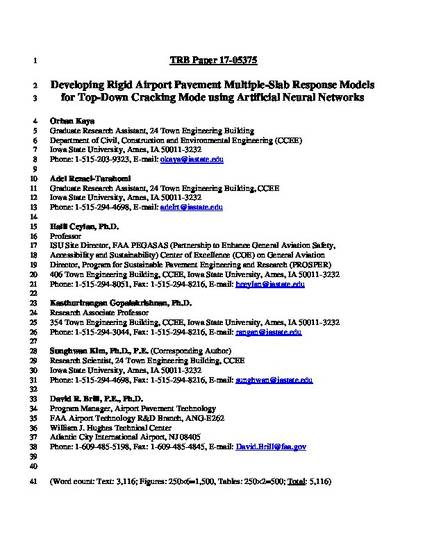
Presentation
Developing Rigid Airport Pavement Multiple-Slab Response Models for Top-Down Cracking Mode using Artificial Neural Networks
TRB 96th Annual Meeting Compendium of Papers
Document Type
Article
Disciplines
Conference
Transportation Research Board 96th Annual Meeting
Publication Version
Published Version
Publication Date
1-1-2017
Conference Date
January 8-12, 2017
Geolocation
(38.9071923, -77.03687070000001)
Abstract
The Federal Aviation Administration (FAA) has recognized for some time that its current rigid 44 pavement design model, involving a single slab loaded at one edge by a single aircraft gear, is 45 inadequate to account for top-down cracking. Thus, one of the major observed failure modes for 46 rigid pavements is poorly represented in the FAA Rigid and Flexible Iterative Elastic Layer 47 Design (FAARFIELD) program. A research version of the FAARFIELD design software has 48 been developed (FAARFIELD 2.0), in which the single-slab three-dimensional finite element 49 (3D-FE) response model is replaced by a 4-slab 3D-FE model with initial temperature curling to 50 produce reasonable thickness designs accounting for top-down cracking behavior. However, the 51 long and unpredictable run times associated with the 4-slab model and curled slabs make routine 52 design with this model impractical. In this paper, use of artificial intelligence (AI)-based 53 alternatives such as artificial neural networks (ANNs) with potential for producing accurate 54 stress predictions in a fraction of the time needed to perform a full 3D-FE computation has been 55 investigated. In the development of ANN models, a synthetic database of FAARFIELD input- 56 output pairs representing a number of realistic scenarios were developed. Moreover, ANN 57 models for only mechanical and simultaneous mechanical and thermal loading cases were 58 developed and accuracy predictions of these models were documented. It was observed that very 59 high accuracies were achieved in predicting pavement responses for all cases investigated.
Copyright Owner
The Authors
Copyright Date
2017
Language
en
File Format
application/pdf
Citation Information
Halil Ceylan, Orhan Kaya, Adel Rezaei Tarahomi, Kasthurirangan Gopalakrishnan, et al.. "Developing Rigid Airport Pavement Multiple-Slab Response Models for Top-Down Cracking Mode using Artificial Neural Networks" Washington, DCTRB 96th Annual Meeting Compendium of Papers (2017) p. 17-05375 Available at: http://works.bepress.com/kasthurirangan-gopalakrishnan/3/

This paper was peer-reviewed by TRB and presented at the Annual Meeting of the Transportation Research Board, Washington, D.C. and can be cited as Kaya, Orhan, Adel Rezaei-Tarahomi, Halil Ceylan, Kasthurirangan Gopalakrishnan, Sunghwan Kim, and David R. Brill. "Developing Rigid Airport Pavement Multiple-Slab Response Models 2 for Top-Down Cracking Mode using Artificial Neural Networks" In Transportation Research Board 96th Annual Meeting, No. 17-05375. 2017. Posted with permission.